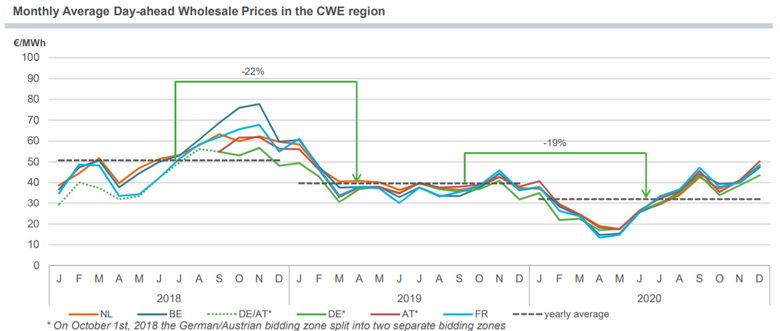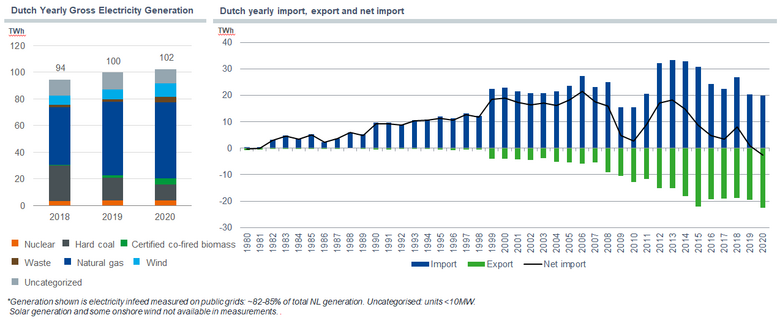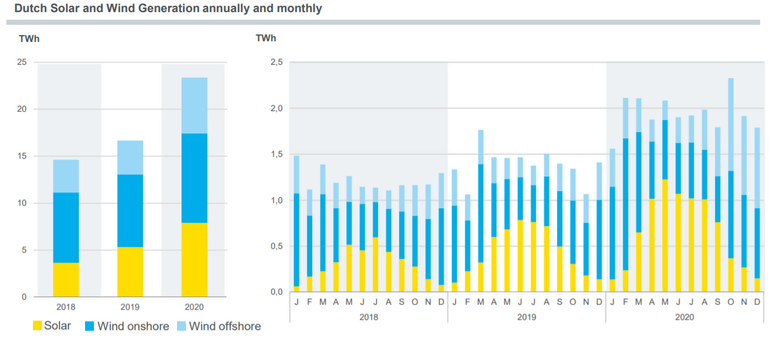- Electricity prices on the European wholesale markets dropped by 19% partly as a result of COVID-19. Especially in the first lockdown period a sharp decrease of market prices, afterwards a recovery is visible.
- In 2020, the Netherlands produced more electricity than in 2019. Mainly with gas plants, solar parks and wind farms. Electricity from coal declines significantly. The Netherlands is a net exporter of electricity for the first time since 1981.
- Electricity generated by sun and wind increases by 40%, mainly due to the commissioning of 3.1 GW of installed capacity of solar panels and the commissioning of the offshore wind farms in Borssele (1.4 GW).
These are the outcomes of the Annual Market Update 2020 of TenneT, cross-border grid operator in the Netherlands and a large part of Germany.
Electricity market prices: prices down due to COVID-19 measures
Electricity market prices in the Central West European (CWE) countries of the Netherlands, Belgium, Germany, France and Austria fell by 19 percent in 2020. The price decreases are mainly due to lockdown measures taken by governments in the COVID-19 pandemic. Due to partial or total lockdown measures, industry in some countries reduced or even halted its production, causing a sharp fall in demand for electricity and gas. From February to May a decline was visible, from June onwards market prices recovered to prices above the annual average of € 32 per MWh.

Electricity generation: gas continues to gain ground on coal
As was the case last year, the margins for gas were largely higher than those for coal. The lower efficiency compared to gas plants (40% coal, 55% gas) and the almost twice as high CO2 emissions of coal plants compared to gas plants worsened the competitive position of coal plants. From January to November, gas plants produced more electricity than coal plants, with a record low for coal in June and July. This applies to both the Netherlands and Germany. Exceptions in Germany to the Dutch pattern are the negative margins in February to May. This is caused by a high supply of electricity from sun and wind in Germany, which pushed the monthly average prices even below the healthy margins of both coal- and gas-fired power plants.
The Netherlands produced slightly more electricity last year than in 2019. Generation increased from 100 TWh in 2019 to 102 TWh in 2020. For the first time since 1981, the Netherlands was a net exporter of electricity. The Netherlands exported electricity mainly to the United Kingdom and Belgium. In Germany, on the other hand, production decreased by 26 TWh last year, mainly due to less generation from coal and lignite plants and nuclear power plants.

Another sharp growth in renewable sources
Of the weather-dependent sustainable sources of electricity, solar energy grew by far the fastest in 2020. In 2020, 7.3 GW of renewable capacity was added in the Netherlands, bringing the total capacity from all energy sources to 41 GW. The installed capacity of solar panels grew the fastest with 3.1 GW. As a result, 49% more solar energy was generated in 2020 than in 2019 (total sunshine 8 TWh). Electricity from offshore wind power grew relatively the fastest (+66%) due to the commissioning of 1.4 GW of capacity from the wind farms near Borssele (total offshore wind 6 TWh). Onshore wind generated 9 TWh last year, bringing the total generation from these sustainable sources to 23 TWh in 2020. This is approximately equal to the annual electricity consumption of the provinces of Noord-Holland and Utrecht combined.
The share of sustainable electricity will further increase in the coming years with the realisation of wind farms at sea and on land and the growth of solar panels on land and on roofs. Maarten Abbenhuis: "In various places, the electricity grid is reaching the limits of its capacity to transmit all this sustainable power. TenneT and the regional grid operators are working hard to jointly accommodate all existing plans and the plans arising from the regional energy strategies (RES), so that the electricity grid remains sustainable, future-proof and affordable."

About the Annual Market Update 2020
The TenneT Annual Market Update provides an overview of relevant developments in the Central West European electricity markets, with a special focus on the Netherlands and Germany, the countries in which TenneT operates. The Market Update 2020 highlights developments in the areas of: electricity prices; fuel prices (gas, coal, CO2 rights); consumption and various forms of electricity generation; subsidy schemes for sustainable electricity production; and interaction (e.g. imports and exports) between the Dutch system and those in neighbouring countries. Special attention is also paid to ensuring the stability and operation of the electricity system by showing the (price) developments for balancing (maintaining the balance between supply and demand) and redispatch (preventing congestion on the grid).




